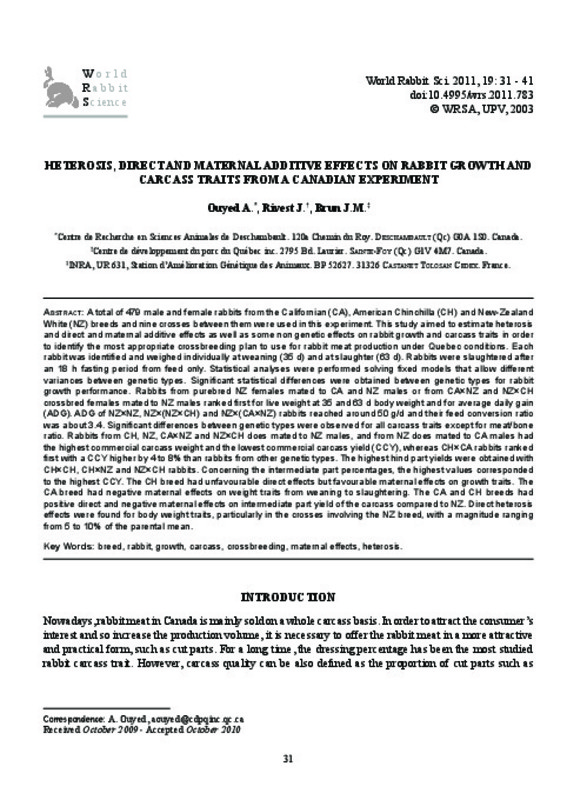JavaScript is disabled for your browser. Some features of this site may not work without it.
Buscar en RiuNet
Listar
Mi cuenta
Estadísticas
Ayuda RiuNet
Admin. UPV
Heterosis, direct and maternal additive effects on rabbit growth and carcass traits from a Canadian experiment
Mostrar el registro sencillo del ítem
Ficheros en el ítem
| dc.contributor.author | Ouyed, Abida
|
|
| dc.contributor.author | Rivest, J.
|
|
| dc.contributor.author | Brun, Jean Michel
|
|
| dc.date.accessioned | 2011-05-09T12:55:59Z | |
| dc.date.issued | 2011 | |
| dc.identifier.issn | 1257-5011 | |
| dc.identifier.uri | http://hdl.handle.net/10251/10906 | |
| dc.description.abstract | A total of 479 male and female rabbits from the Californian (CA), American Chinchilla (CH) and New-Zealand White (NZ) breeds and nine crosses between them were used in this experiment. This study aimed to estimate heterosis and direct and maternal additive effects as well as some non genetic effects on rabbit growth and carcass traits in order to identify the most appropriate crossbreeding plan to use for rabbit meat production under Quebec conditions. Each rabbit was identified and weighed individually at weaning (35 d) and at slaughter (63 d). Rabbits were slaughtered after an 18 h fasting period from feed only. Statistical analyses were performed solving fixed models that allow different variances between genetic types. Significant statistical differences were obtained between genetic types for rabbit growth performance. Rabbits from purebred NZ females mated to CA and NZ males or from CAxNZ and NZxCH crossbred females mated to NZ males ranked first for live weight at 35 and 63 d body weight and for average daily gain (ADG). ADG of NZxNZ, NZx(NZxCH) and NZx(CAxNZ) rabbits reached around 50 g/d and their feed conversion ratio was about 3.4. Significant differences between genetic types were observed for all carcass traits except for meat/bone ratio. Rabbits from CH, NZ, CAxNZ and NZxCH does mated to NZ males, and from NZ does mated to CA males had the highest commercial carcass weight and the lowest commercial carcass yield (CCY), whereas CHxCA rabbits ranked first with a CCY higher by 4 to 8% than rabbits from other genetic types. The highest hind part yields were obtained with CHxCH, CHxNZ and NZxCH rabbits. Concerning the intermediate part percentages, the highest values corresponded to the highest CCY. The CH breed had unfavourable direct effects but favourable maternal effects on growth traits. The CA breed had negative maternal effects on weight traits from weaning to slaughtering. The CA and CH breeds had positive direct and negative maternal effects on intermediate part yield of the carcass compared to NZ. Direct heterosis effects were found for body weight traits, particularly in the crosses involving the NZ breed, with a magnitude ranging from 5 to 10% of the parental mean. | es_ES |
| dc.language | Inglés | es_ES |
| dc.publisher | World Rabbit Science. ICTA. UPV | es_ES |
| dc.relation.ispartof | World Rabbit Science | |
| dc.rights | Reserva de todos los derechos | es_ES |
| dc.subject | Breed | es_ES |
| dc.subject | Rabbit | es_ES |
| dc.subject | Growth | es_ES |
| dc.subject | Carcass | es_ES |
| dc.subject | Crossbreeding | es_ES |
| dc.subject | Maternal effects | es_ES |
| dc.subject | Heterosis | es_ES |
| dc.title | Heterosis, direct and maternal additive effects on rabbit growth and carcass traits from a Canadian experiment | es_ES |
| dc.type | Artículo | es_ES |
| dc.date.updated | 2011-05-06T13:12:24Z | |
| dc.identifier.doi | 10.4995/wrs.2011.783 | |
| dc.rights.accessRights | Abierto | es_ES |
| dc.description.bibliographicCitation | Ouyed, A.; Rivest, J.; Brun, JM. (2011). Heterosis, direct and maternal additive effects on rabbit growth and carcass traits from a Canadian experiment. World Rabbit Science. 19(1). https://doi.org/10.4995/wrs.2011.783 | es_ES |
| dc.description.accrualMethod | SWORD | es_ES |
| dc.description.volume | 19 | |
| dc.description.issue | 1 | |
| dc.identifier.eissn | 1989-8886 | |
| dc.identifier.eissn | 1989-8886 | es_ES |








